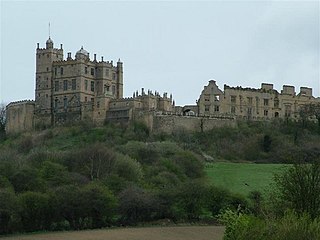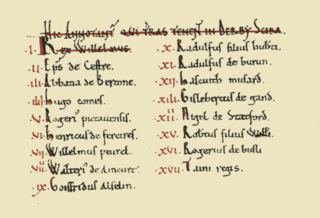
Bolsover Castle is in the town of Bolsover, in the north-east of the English county of Derbyshire. Built in the early 17th century, the present castle lies on the earthworks and ruins of the 12th-century medieval castle; the first structure of the present castle was built between 1612 and 1617 by Sir Charles Cavendish. The site is now in the care of the English Heritage charity, as both a Grade I listed building and a Scheduled Ancient Monument.

Castleton is a village in the High Peak district of Derbyshire, England, at the western end of the Hope Valley on the Peakshole Water, a tributary of the River Noe, between the Dark Peak to the north and the White Peak to the south. The population was 642 at the 2011 Census.

The title Baron Berkeley originated as a feudal title and was subsequently created twice in the Peerage of England by writ. It was first granted by writ to Thomas de Berkeley, 1st Baron Berkeley (1245–1321), 6th feudal Baron Berkeley, in 1295, but the title of that creation became extinct at the death of his great-great-grandson, the fifth Baron by writ, when no male heirs to the barony by writ remained, although the feudal barony continued. The next creation by writ was in 1421, for the last baron's nephew and heir James Berkeley. His son and successor William was created Viscount Berkeley in 1481, Earl of Nottingham in 1483, and Marquess of Berkeley in 1488. He had no surviving male issue, so the Marquessate and his other non-inherited titles became extinct on his death in 1491, whilst the barony passed de jure to his younger brother Maurice. However William had disinherited Maurice because he considered him to have brought shame on the noble House of Berkeley by marrying beneath his status to Isabel, daughter of Philip Mead of Wraxhall, an Alderman and Mayor of Bristol. Instead he bequeathed the castle, lands and lordships comprising the Barony of Berkeley to King Henry VII and his heirs male, failing which to descend to William's own rightful heirs. Thus on the death of King Edward VI in 1553, Henry VII's unmarried grandson, the Berkeley inheritance returned to the family. Therefore, Maurice and his descendants from 1492 to 1553 were de jure barons only, until the return of the title to the senior heir Henry, becoming de facto 7th Baron in 1553. Upon his death he was succeeded by his relative George Harding.

A feudal baron is a vassal holding a heritable fief called a barony, comprising a specific portion of land, granted by an overlord in return for allegiance and service. Following the end of European feudalism, feudal baronies have largely been superseded by baronies held as a rank of nobility, without any attachment to a fief. However, in Scotland, the feudal dignity of baron remains in existence, and may be bought and sold independently of the land to which it was formerly attached.
William Peverel, Latinised to Gulielmus Piperellus), was a Norman knight granted lands in England following the Norman Conquest.
William I de Ferrers, 3rd Earl of Derby was a 12th-century English Earl who resided in Tutbury Castle in Staffordshire and was head of a family which controlled a large part of Derbyshire known as Duffield Frith. He was also a Knight Templar.

The Forest of High Peak was, in medieval times, a moorland forest covering most of the north west of Derbyshire, England, extending as far south as Tideswell and Buxton. From the time of the Norman Conquest it was established as a royal hunting reserve, administered by William Peverel, a follower of William I, who was based at Peveril Castle. The Royal Forest of Peak was bounded by the River Goyt to the west, the River Wye to the south, the River Derwent to the east and the River Etherow to the north. In 1305 it covered about 100 square miles.
Glossop Castle is a Norman earthwork north of Glossop, off Hilltop Road, 14 miles (23 km) east of Manchester, on the A57. The site is visible from the main road, standing atop a commanding ridge. Some 12 miles (19 km) southeast is Peveril Castle.

Mulgrave Castle refers to one of three structures on the same property in Lythe, near Whitby, North Yorkshire, England. One of these, known as the "old" or "ancient" castle, was by legend founded by Wada, a 6th-century ruler of Hälsingland. The second castle, caput of the feudal barony of Mulgrave, was of Norman construction and remained active until destroyed by order of Parliament in 1647. The third is a country house which was constructed by Lady Catherine Darnley and passed in 1718 by marriage into the Phipps family, when her daughter Lady Catherine Annesley married William Phipps. The Phipps family later held the titles of Baron Mulgrave, Earl of Mulgrave and Marquess of Normanby.

The Honour of Wallingford was a medieval English feudal barony which existed between 1066 and 1540 with its caput at Wallingford Castle in present-day Oxfordshire.

In the kingdom of England, a feudal barony or barony by tenure was the highest degree of feudal land tenure, namely per baroniam, under which the land-holder owed the service of being one of the king's barons. The duties owed by and the privileges granted to feudal barons are not exactly defined, but they involved the duty of providing soldiers to the royal feudal army on demand by the king, and the privilege of attendance at the king's feudal court, the precursor of parliament.

Peveril Castle is a ruined 11th-century castle overlooking the village of Castleton in the English county of Derbyshire. It was the main settlement of the feudal barony of William Peverel, known as the Honour of Peverel, and was founded some time between the Norman Conquest of 1066 and its first recorded mention in the Domesday Survey of 1086, by Peverel, who held lands in Nottinghamshire and Derbyshire as a tenant-in-chief of the king. The town became the economic centre of the barony. The castle has views across the Hope Valley and Cave Dale.

From AD 1066, the feudal barony of Barnstaple was a large feudal barony with its caput at the town of Barnstaple in north Devon, England. It was one of eight feudal baronies in Devonshire which existed in the Middle Ages. In 1236 it comprised 56 knight's fees or individual member manors. The feudal service owed for half the barony in 1274 was the provision to the royal army of two knights or four sergeants for forty days per annum, later commuted to scutage.

The feudal barony of Okehampton was a very large feudal barony, the largest mediaeval fiefdom in the county of Devon, England, whose caput was Okehampton Castle and manor. It was one of eight feudal baronies in Devonshire which existed during the mediaeval era.
The feudal barony of Gloucester or Honour of Gloucester was one of the largest of the mediaeval English feudal baronies in 1166, comprising 279 knight's fees, or manors. The constituent landholdings were spread over many counties. The location of the caput at Gloucester is not certain as Gloucester Castle appears to have been a royal castle, but it is known that the baronial court was held at Bristol in Gloucestershire.

The Feudal barony of Trematon was one of the three feudal baronies in Cornwall which existed during the mediaeval era. Its caput was at Trematon Castle, Cornwall. In 1166 it comprised 59 knight's fees, thus about 59 separate manors.

The feudal barony of Plympton was a large feudal barony in the county of Devon, England, whose caput was Plympton Castle and manor, Plympton. It was one of eight feudal baronies in Devonshire which existed during the medieval era. It included the so-called Honour of Christchurch in Hampshire, which was not however technically a barony. The de Redvers family, first holders of the barony, were also Lords of the Isle of Wight, which lordship was not inherited by the Courtenays, as was the barony of Plympton, as it had been sold to the king by the last in the line Isabel de Redvers, 8th Countess of Devon (1237–1293).

The feudal barony of Appleby was a feudal barony with its caput at Appleby Castle in Appleby, Westmorland, England.

The Domesday Book of 1086 AD lists King William the Conqueror's tenants-in-chief in Derbyscire (Derbyshire), following the Norman Conquest of England:















